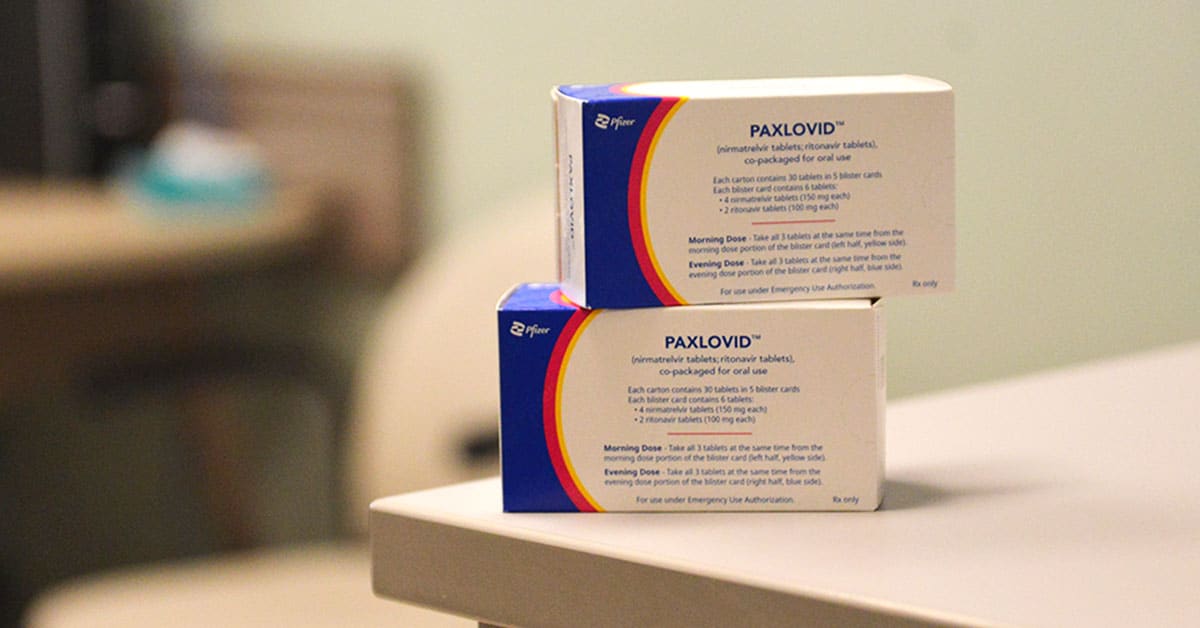
After Health Canada approved Pfizer’s Paxlovid to treat COVID-19 as an at-home prescription medication in Canada, 11,000 doses were shipped across the province to clinics such as the COVID assessment clinic (CAC) at St. Mary’s General Hospital in Kitchener.
This the first oral medication that can prevent people with COVID from becoming severely ill, helping to relieve some of the pressure COVID has put on hospitals. It’s not a replacement for vaccination and is in short supply currently, so only those considered high-risk are being prescribed Paxlovid in the region.
“I will say it’s sort of long awaited. Since the beginning of the pandemic, they’ve been hoping that there might be an oral drug to fight the virus,” said Dr. Mary Jackson, respirologist and physician co-lead for the St. Mary’s COVID response. “There was really a feeling, especially with this last wave being so significant that we needed to get the drug available to people who were at high risk of having severe disease.”
St. Mary’s was one of 15 locations chosen to distribute the new medication, which came with strict instructions about who should receive it.
Canada secured one million treatment courses of Paxlovid from Pfizer and is still awaiting most of that supply as only 30,400 Paxlovid doses have been received so far, with more to come in March.
“The drug is available for those with symptoms for a specific group of patients – we are seeing some increase uptake,” Lee Fairclough, president of St. Mary’s General Hospital, said Friday during the region’s weekly pandemic briefing.
Like other medications for illness, Pfizer’s Paxlovid comes with a usage guidelines.
“We worked with the Ontario Science table to help develop guidance for healthcare providers for prescribing it,” said Prof. Kelly Grindrod of the University of Waterloo School of Pharmacy.
“While we’re still learning how to use it and we’re still getting limited supply, they’re restricting it to older people, because the older people are much more likely to end up needing hospital care or dying from COVID. Then those that have additional risk factors, so immunocompromised conditions, serious health conditions, Indigenous communities. I think once we have a much greater supply you’ll see the eligibility criteria being much more wide open, but we need enough drug to be able to achieve that.”
After a resident feels they have symptoms of COVID-19 and fall into the high-risk category, they can talk to their doctor about getting tested at the CAC and getting access to Paxlovid. If they test positive, they will be asked a variety of questions to determine if the medication won’t mix with anything that person is already taking, and a pharmacist will coach them how to take the medication. The prescribed medication will then be sent to their home for the COVID positive patient to take to relieve their symptoms and prevent further infection.
“It’s a huge shift in how we could potentially be treating COVID,” noted Grindrod.
Many of the patients receiving Paxlovid are seniors who may be unvaccinated or have underlying conditions.
“It is very, very hard to treat this condition when people get a severe case of COVID. What this does, where this changes is this is a very simple-to-take treatment from a patient perspective. It’s something you take twice a day for five days and you do it from home,” said Grindrod
“Our pharmacists are checking back in with patients after a couple of days and they’re also encouraged to contact their family doctors. The word that we have is that patients are feeling steadily better,” said Jackson.
“The idea is that the drug is blocking the virus from just endlessly reproducing itself. And so, if at the beginning you just have a small amount of virus then it’s only going to produce a small amount of damage. But if you let the virus really reproduce over and over then the downstream consequence can be much more severe.”
Current limitations on who can prescribe Paxlovid may change as more supply becomes available in Canada.
“I’m not 100 per cent sure that the public or even healthcare providers realize just how much of an impact this could have once we’re actually comfortable and able to use it easily,” said Grindrod.
Anyone already taking medication but experiencing COVID symptoms should talk to their family doctor before seeking Paxlovid as a treatment option as it may interact with their current medications.
So far, few side effects have been reported other than a strange taste in patients’ mouths, said Grindrod.
Oral medications like Paxlovid to treat COVID-19 could help ease the strain local hospitals are still feeling as less people will need to come in for being severely ill. It blocks the virus from replicating, reducing the severity of symptoms.
“It’s very challenging. Fortunately, the numbers of COVID patients being admitted to the hospital is decreasing. We still have some that are recovering from illness in the hospital, but the numbers in hospital across the province and in our ICUs is decreasing, all of which is good news,” said Jackson. “The province has given us the green light to try and get back to resuming some of our surgical procedures and diagnostic things, but we still have a big challenge because of inadequate numbers of staff.
“We’re starting to see some improvement in that area. Each hospital will work as hard as they can to get at backlogs, but it’s going to take us a long time to dig our way out.”









